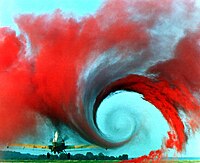Aeronautical Engineering/General introduction
What is Aeronautical Engineering?
[edit | edit source]
Broadly speaking, it is the branch of engineering that deals with the design and construction of aircraft. This can range from the cutting-edge technology of today's modern fighter aircraft, with sustained cruising speeds well over the speed of sound, to aircraft design to carry many hundreds of people thousands of miles around the world in comparative luxury and with extraordinary efficiency.
However, aeronautical engineering is more than that. Aeronautical engineers are needed in the construction of modern buildings, and in the analysis of the behaviour of spacecraft within the Earth's (and other planetary bodies') atmosphere. Other products requiring their input include missiles, rockets, helicopters, turbines and experimental engines, spacecraft and high-speed racing cars and catamarans.
Study Areas
(stolen wholesale from Wikipedia)
- Fluid mechanics - the study of fluid flow around objects. Specifically aerodynamics concerning the flow of air over bodies such as wings or through objects such as wind tunnels (see also lift and aeronautics).
- Dynamics and engineering mechanics - the study of movement, forces, moments in mechanical systems.
- Mathematics - as most subjects within aerospace engineering involve equations and mathematical manipulation and derivations, a solid and comprehensive study of mathematics is required to enable effective learning in the other modules.
- Electrotechnology - the study of electronics within engineering.
- Propulsion - the energy to move a vehicle through the air (or in outer space) is provided by internal combustion engines, jet engines and turbomachinery, or rockets (see also propeller and spacecraft propulsion).
- Control engineering - the study of mathematical modelling of systems and designing them in order that they behave in the desired way. As aircraft flight control systems are becoming increasingly complex, they can be studied as a separate module.
- Aircraft structures - design of the physical configuration of the craft to withstand the forces encountered during flight. Aerospace engineering aims very much at keeping structures lightweight.
- Materials science - related to structures, aerospace engineering also studies the materials of which the aerospace structures are to be built. New materials with very specific properties are invented, or existing ones are modified to improve their performance.
- Aeroelasticity - the interaction of aerodynamic forces and structural flexibility, potentially causing flutter, divergence, etc.
- Avionics - concerning the design and integration of electronic systems on board an aircraft or spacecraft. Communications and navigation equipment may be the focus of this study.
- Risk and reliability - the study of risk and reliability assessment techniques and the mathematics involved in the quantitative methods.
- Noise control - the study of the mechanics of sound transfer. Required as noise levels are a massive consideration in the current aerospace industry.
- Flight test - the discipline of designing and executing flight test programs in order to gather and analyze performance and handling qualities data in order to determine if an aircraft meets its design and performance goals and certification requirements.
Leading Edges
[edit | edit source]- Study of insect regimes for insight into microflyers
- Robotics or unmanned aerial vehicles of all sizes
- Highly automated manufacturing techniques allowing custom building or tailoring
A Potted History of Flight
[edit | edit source]The history of flight has been propelled and directed, more than almost any other industry, by the superhuman efforts of individuals. Bicycle manufacturers and powerful businessmen alike, the vision and bravery of these individuals has pushed aviation to such dizzying heights that today at the beginning of the 21st century, and after only a century of flight, it is taken completely for granted that we can fly thousands of feet above the ground and hundreds of miles per hour in complete safety and comfort. We even have the gall to complain about the complimentary breakfast!
At the beginning, there were guys with wing-shaped material stretched over lightweight frames jumping off mountains - they were the first 'birdmen'.
- "Human beings have always dreamed of flight. They did not however, dream of the Boeing 747. The flight to which humans traditionally aspired was that of the birds, a business of feathers and flapping wings" - Flight: 100 Years of Aviation, R. G. Grant
Names: Roger Bacon, Leonardo da Vinci, Otto Lilienthal, Francesco de Lana, Joseph/Etiene Montgolfier, Jean-Pierre Blanchard, George Cayley, Samuel Henson, Hiram Maxim, Octave Chanute, Orville/Wilbur Wright,
